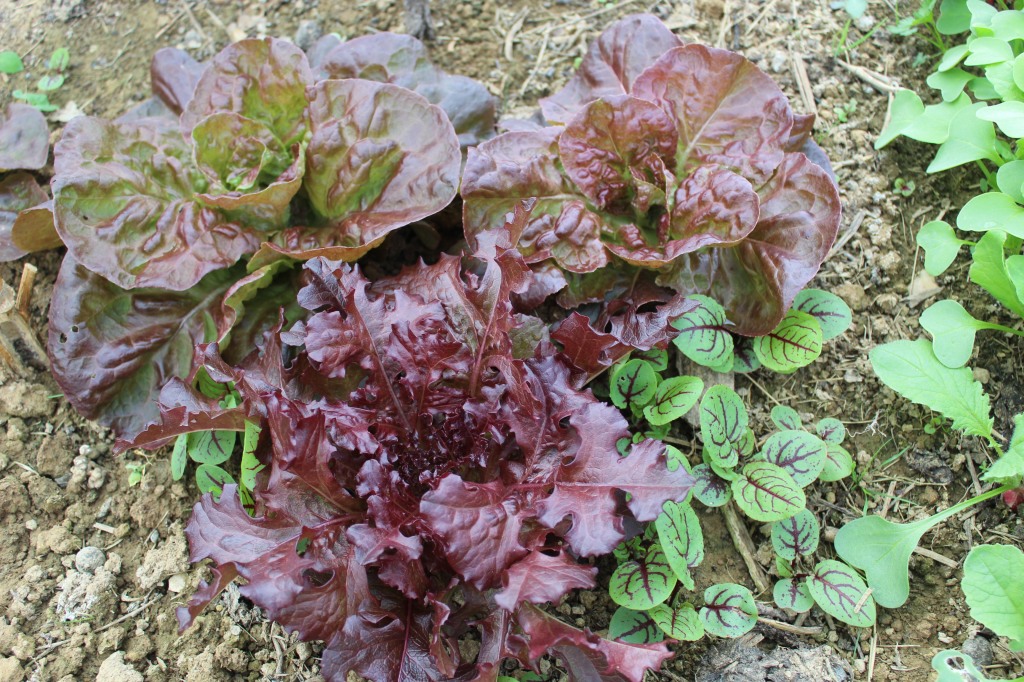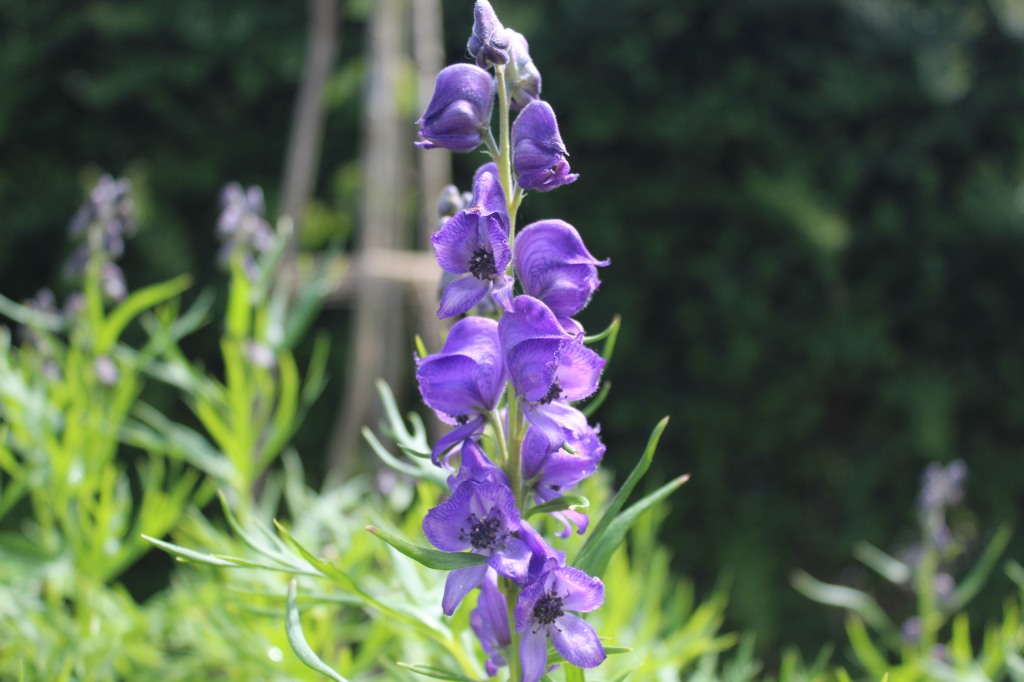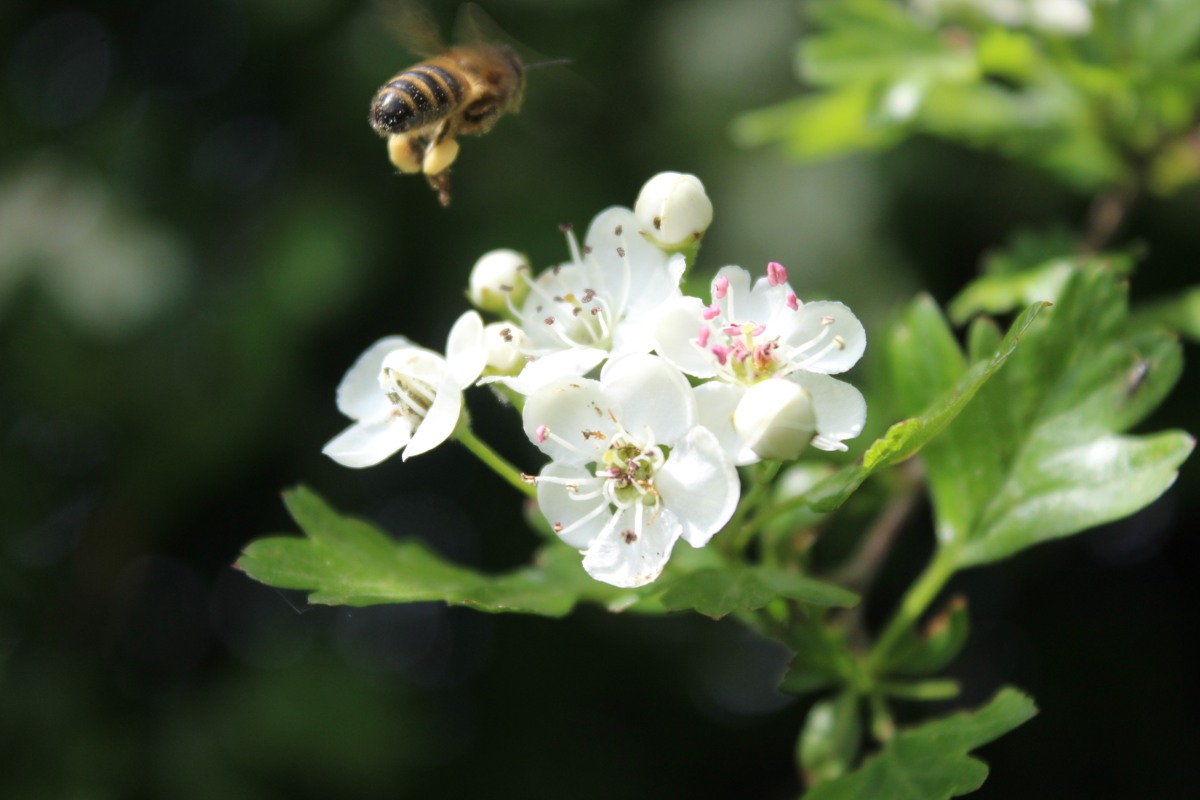It’s quite the year for blossom and the air is so heavily scented, it’s almost intoxicating. Setting my morning tea to brew, I wander outside in my pyjamas, listen to the babble of the birds and simply breathe. In France, lily-of-the-valley with its delicate waxen flowers and heavenly perfume is traditionally associated with May Day, but in the local landscape there is no doubting that the wilder, more seductive hawthorn is the May queen; the trees and hedgerows are a blizzard of come-hither white and alive with the attention of pollinators. I’ve been watching the honey bees working in the large hawthorn next to the (still very empty) pond and I’m struck by their rather agitated and feisty attitude, the kind that beekeepers expect in August when the honey stores are full and in need of protection. Is there something about the may blossom that puts them on edge, I wonder? Or maybe it’s the weather, this strange mix of hot sunshine, cold wind and air so dry it almost crackles? Whatever is going on, the little honeys certainly wouldn’t sit still for a photo.

The moles are restless, too, pushing up mountainous tumps as they tunnel ever deeper in search of worms; this dry weather doesn’t seem to suit them much, either. Where the hills appear in grass, I’m gathering the soil to mix with compost and use as a planting mix for the tender outdoor vegetables but I really wish they would stop tunnelling under the garden and lifting young plants; I’ve had to tread more cabbages, lettuce, garlic and broad beans back in than I can count, but at least the deep mulch around them is doing its job and there is still moisture around their roots. That’s more than can be said for the seedlings which are struggling enough already without being pushed out of the ground on a regular basis; I just have to keep tucking them back in, watering and hoping they survive the ongoing battle.

On the subject of battles, I was born a few miles from the site of the Battle of Shrewsbury where, in July 1403, King Henry IV fought an army of rebel barons led by Henry ‘Hotspur’ Percy, and English archers unleashed the deadly longbow on each other for the first time. The events of the battle are well-documented but for me, the most poignant fact is that the battle took place in a field of peas. I can’t begin to imagine the terrible carnage wrought by medieval warfare but I’ve often wondered what sort of longer term misery the destruction of that valuable crop must have brought. The pea plants would have been fixing nitrogen and so enriching the soil (centuries before the advent of synthetic agricultural fertilisers), the straw made good fodder for animals, especially cattle, and the peas themselves would have been destined to be dried and stored to be eaten as an essential source of vegetable protein during the lean months of winter and spring, with some saved for planting the following year. History tells how young Prince Hal made a miraculous recovery from an arrow wound in the face and lived to become the famous soldier-king, Henry V . . . but how many ordinary folk struggled (or failed) to survive the winter because a vital harvest was trampled beneath the hooves of destriers?

These days, of course, the citizens of Shrewsbury have a wide choice of commercial outlets where they can buy a huge range of food in all seasons and from all over the globe . . . and yet food security remains a salient concern; the effects of the pandemic and events in Ukraine have highlighted just how fragile and vulnerable the ‘just in time’ food supply chain is and if we add climate change, loss of topsoil, scarcity of water and the like, the picture can seem somewhat gloomy. For me, the answer is simply to get out there and grow food; we are very lucky that we have the time, space and wherewithal and for that, I am extremely grateful. We have never set out to be self-sufficient but more and more, it makes sense to produce and use as much as we can.

On a recent foray to the charity shop to buy some ‘new’ books, I was delighted to pick up a copy of Tribes of Britain by eminent archaeologist David Miles; I’m thoroughly enjoying it and I’m glad that at 450 pages long, I shouldn’t finish it too quickly. Agriculture (and by association, gardening) arrived in the British Isles relatively late and I find myself fascinated by the lives of those early peoples who hunted and gathered in my native land before they became farmers. Don’t get me wrong. I’m not given to romanticising history; life was tough and brutally short and I’m not planning to take up flint knapping any time soon, although I suspect it would be an interesting activity and a skill I would struggle to perfect. I simply find that the more I read, the more I find inspiration in the innovation, resilience and above all, adaptability, that those people demonstrated; there are still valuable lessons there for us today, so many millennia later. Having spent the last year establishing a garden where we can grow food, our focus this year is on using every scrap of what we manage to produce. In many ways, it’s an exciting project and we’re busy researching a wealth of different methods of using and preserving our harvest. Don’t listen to anyone who tells you that you can’t teach old dogs new tricks; we’re never too old to learn and the fact that things like sourdough bread, herbal teas and lacto-fermented vegetables have become a part of our everyday lives in recent years is testament to that. It’s only taken us 30 years to discover that Jerusalem artichokes are delicious raw and there is still a list of new foods I’d like to try growing. Interesting times ahead!

We’re already researching a number of new techniques to try and different preserves to make through the summer and autumn seasons, especially using what we hope will be a bumper crop of peppers, aubergines, beans and courgettes (I don’t use the word ‘glut’ any more, we simply can’t have too much of anything!). Chutneys and pickles are top of the list and where fruit is concerned, the juice press doesn’t have to be limited to apples.

We’re planning to build a simple smoker and Roger fancies a go at home brewing, something we haven’t done for years. There’ll be lots of drying to be be done, too; dried apple rings and fruit leathers have been a hit and we’ve pretty much emptied the herbal tea jars so I have a good idea of what we need to collect more of this year – I’ve already started drying peppermint on the windowsills and as Roger has developed a taste for meadowsweet, we definitely need a few good foraging trips along the lanes once that’s in flower.

I’m not a big fan of bedding plants although I recognise their usefulness and have been guilty on occasion of succumbing to their ease-of-life attractions. They are, however, something of an ecological nightmare, requiring vast quantities of heat, water, compost, plastic, chemical treatments and transportation in order to provide what amounts to a few weeks of colour before next season’s offerings arrive in the shops; they’re a sort of ‘fast fashion’ of the floral world. This time last year, having so many other things to do, I bought a tray of trailing pelargoniums in the hope of having a reliable splash of summer colour in the window boxes at the front of the house, something that wouldn’t require too much fuss and which could cope with the heat. To be fair to the plants, they did the job.

The problem for me, though, is that they are pretty sterile things and offer very little else: they have no scent, they don’t really work as cut flowers and the insects shun them, Also, despite my best nurturing efforts in the tunnel, only three of them made it through the winter. In contrast, the pansies that preceded them were far more generous. Yes, they were also bedding plants but they provided a wider range of colour and a valuable food supply for bumble bees in particular in early spring; they are an edible flower for us, too, and popped their seeds all over the gravel giving me plenty of seedlings to lift and replant. I have to admit the babies were very slow to get going – we’ve had a few slug issues – but they’ve been worth the wait. It’s has had me thinking that for this summer I’m going to do things differently: it could be a raging success or an unmitigated disaster but I won’t know until I’ve tried. I’ve planted the three pelargoniums in a hanging basket for the little courtyard outside the back door and filled the troughs they were in last year with mixed lettuce plants and a few nasturtium seeds. I’ve also planted a blue glazed pot with flat-leaved parsley and violas in the hope that, together with the pots of herbs on the wall, this area will sing out the ‘food and flowers’ thing I’ve got going on everywhere.

For the window boxes, I’m raising some zinnias from seed, which I’m hoping will provide long-lasting pops of bright colours and a feast for butterflies and hoverflies, with violas and a few trailing nasturtiums sown between to pick for salads. It’s going to be a long way from the traditional look but I can’t help feeling it’s a better way of doing things. We’ll see . . .

The annual flower seedlings are struggling in this dry weather, the soil is so parched and they desperately need rain. Not surprisingly, it’s the sunflowers that are looking the happiest and nasturtium volunteers are bombing up everywhere. There is certainly no shortage of flowers to enjoy at the moment, though; I just hope we still manage a riot of summer colour. Come on, rain.








Today is officially the Big Plant-a-thon: I’ve started planting a few things out, but the next few hours are going to be spent getting everything into the ground – French, borlotti and Asturian beans, squash, aubergines, peppers, chillies, melons and the rest of the courgettes. They’ll all need watering which is going to pretty much empty the last of our rain butts but there is a tiny glimmer of hope on the horizon with a slight possibility of showers this afternoon before the temperature hikes up into the mid-twenties for the foreseeable future. There’s an old country saying that goes Be it dry or be it wet, Nature always pays the debt . . . I have all my fingers and toes crossed that it’s sooner rather than later! 😬


🥰 everything looks amazing Lis!
LikeLiked by 1 person
Thanks, Trace! Just desperately need some rain now. 🤞🤞🤞
LikeLike
Such beautiful images, I especially love the little bee shot!
LikeLiked by 1 person
Thank you, Dorothy! They were so very busy, I was lucky even to get that shot . . . most of them were off-screen, even using a sport setting on the camera! 😂
LikeLiked by 1 person
Well, you did a great job!
LikeLiked by 1 person
Another heartening report on the evolving life of your land and your hard work in supporting that evolution. I also enjoyed your reflection on ‘the field of peas’, not an aspect of war that gets much attention, and the way you linked this history to present events.
LikeLiked by 1 person
Thank you for your comment, James. It’s so true that the history of war is all about the victors, we can only guess at the effects on ordinary folk. I would certainly be devastated to find our garden flattened but at least we are lucky enough to have alternatives.
LikeLiked by 1 person
Isn’t the weather strange? We have had rain every week throughout the last two weeks of March, all of April andthe first week of May. Murciano neighbours can’t remember anything like this. Torrential rain last week washed away part of a road on our urbanization! On the plus side, everything is beautifully green and wild flowers border all the country roads…it won’t last! The desert will return and with it the need for our watering systems ! I was in Edinburgh at Easter and it was drier than Murcia. Que pasa? Have you had your much needed showers yet?
LikeLiked by 2 people
It sounds like Murcia is the new Asturias! 😉 We expect a long, dry, hot spell here but in July and August, not this early. We emptied the butts yesterday so now we’re having to use tap water to keep everything alive plus every scrap of grey water – we’re missing that mountain spring! We’ve still not had a drop of rain but thundery showers have appeared in the forecast for Sunday so fingers are firmly crossed. Hope you are enjoying the green and flowers while you can! x 😊
LikeLiked by 2 people
Beautiful fotos🤗
LikeLiked by 2 people
Thank you!
LikeLiked by 1 person
Hi Lis!! I can not believe how long it has taken me to catch up on your blog! I have half read some of your most recent posts, but this has just been a busy term with work and the kids activities spread out – my free time went poof! But I am finally sitting down now and will spend the next enjoyable hour or two catching up on your news (I did see photos of your incredible trip to Norway, so really looking forward to finishing that post!). Your garden is looking wonderful but I am sorry for your mole and dry weather woes. I found your story about the historical battle in your home town very interesting – we have no history of ‘destriers’ (I did in fact have to look that one up!) in Australia. While that particular season’s crop of peas was destroyed, which no doubt would have impacted the population and their stock terribly, I wonder if the blood spilt made up in some way for the loss of nitrogen from the crop. A gruesome thought I know.
LikeLiked by 2 people